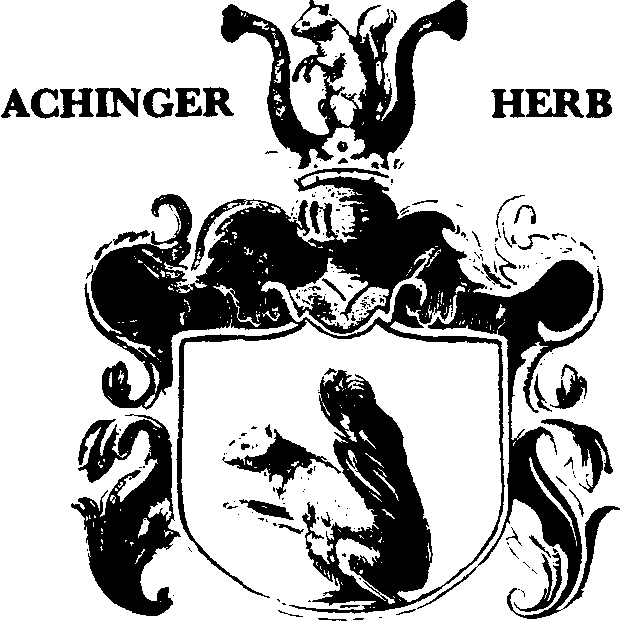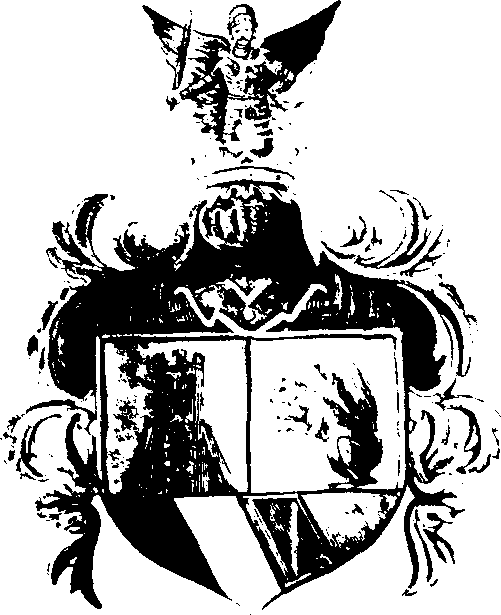Herb Achinger
Research Heraldry Herb Achinger
Herbarz Polski Translation
Achinger herb
 The following article is a direct translation from the classic Genealogical and Heraldic reference "Herbarz Polski " by Kasper Niesiecki S.J., (Lipsk) edition 1839-46.
The following article is a direct translation from the classic Genealogical and Heraldic reference "Herbarz Polski " by Kasper Niesiecki S.J., (Lipsk) edition 1839-46.
Described by Paprocki, Okolski, Potocki and Rutka, thus: a red squirrel, its under breast white, in a golden field, racing to the right of the crest, its tail held high on its back; above the crest, a like squirrel, as tho sitting between two horns. Okolski adds (which I too can see) that the squirrel on the helmet is apparently sitting between antlers, its head turned back to the left of the crest. Although the authors are silent as to its origin, all agree that the crest was brought to Poland from Germany.
Foreigners write of an "Eizynger" in 1455, most prominent among Austrian Lords and highly regarded by Ladislaus, the Czech-Hungarian King. Although elevated through good fortune, the jealousy of others caused his downfall and false accusations made before the King brought disgrace and expulsion from the royal court.
The first to arrive in Poland with this crest was ZYBULD AICHINGER, during the reign of Zygmunt I, according to Starowolski. He also ascribes it to Baldwin, the eleventh Bishop of Krakow, who lived 400 years before Zygmunt. Starowolski writes that after the death of Lambert, Wladyslaw, the Prince of Poland, conferred the Krakow Bishopric on Ceslaw. However, because Ceslaw took over the Cathedral without the Pope's confirmation, the Papal Nuncio, Gwallo, Bishop of Bellowak, compelled him to withdraw and replaced him with Baldwin, the Frenchman, formerly "Pallatii Apostolici Auditor," later Canon Stobnicki, Papal Commissioner of the Peter Pence collection. On the recommendation of Boleslaw the Wrymouth, Baldwin was consecrated by Urban II. Everyone found him pleasant and gracious, far removed from putting on airs, generous to the poor, lavishly sharing his own provisions. After five years in office, he passed on to eternity in 1108.
From this I deduce the antiquity of the AICHINGER house, with the understanding that at this time, Baldwin arrived in Poland alone. Later, during King Zygmunt's time, the family began to settle here. The fact that they write of Baldwin as being French by birth, but that the family came here from Germany, is by no means a contradiction because the AICHINGER ancestors, although residing in Germania, had their origins in Oriental France which can be seen from the gravestone of August Aichinger in Krakow at Holy Trinity where the inscription reads: "Eques Franciae Orientalis a Facha."
ZYBULT AICHINGER, the first to savor Polish freedom, settled in Russia where he married Maleczkowska, sister of Michal, Governor of Krakow, by whom he had two sons:
Zybult, whose proficiency in many areas and good manners won him great favor with Bogdan, Hospodar of Walachia. Of his issue with Zarszynska in Pokucie, one son served with Stanislaw Potocki, Voivode of Krakow and Commander-in-Chief, in 1665, and the other, with Field Commander Kazanowski under the Usar Banner. Both sacrificed their lives for the common good.
And Jerzy, Court Chamberlain to Stefan Batory who, having perceived Jerzy's competence in a variety of roles, sent him on dangerous missions beyond the borders which he conducted with bravery. He married Gajewska of the Hungarian court. The Hungarian writer, Istvantius, praising the great name of AICHINGER in that Kingdom, notes that Lupus Aichinger was a Commissioner at the peace treaties with the Turks.
AUGUSTYN AICHINGER, cousin of Zybult and Jerzy, fluent in Turkish, Greek, Latin, Polish, German and Valachian languages, acquired in his peregrinations to the holy places in Jerusalem and the many courts of European Lords, after memorable deeds on battlefields and off, died in Krakow in 1582. Paprocki writes in his book on heraldry of Augustyn's gravestone, erected by his cousin Jerzy, and in his folio 583, you will find the charter granted by Emperor Rudolf in 1577 to Augustyn and his brothers, and extended to his cousins Zybult and Jerzy and their progeny wherein, having praised their knightly deeds  and loyalty to him, he changed the form of' the family crest in the following manner: a shield divided horizontally into two parts, the lower on the bottom contains four fields separated by diagonal lines running from the right in which the first field from the right is black; the second is yellow or gold: the third, red; and the fourth white or silver. The second, higher part, divides vertically into two parts: on the left side of the shield, a green hill with three peaks, on the highest of which is a squirrel in natural color, its head turned to the right, its tail held upward, legs braced as if to jump, in a yellow or gold field; on the right side, a white bastille in a red field, its gate and two windows, black. On the helmet, a crown above which are widespread wings: the left is yellow underneath and black, above; the right wing, red below, and white on top. Between the wings stands a man in armor, visible to the waist, with gold sword unsheathed, hilt in hand, and a golden apple.
and loyalty to him, he changed the form of' the family crest in the following manner: a shield divided horizontally into two parts, the lower on the bottom contains four fields separated by diagonal lines running from the right in which the first field from the right is black; the second is yellow or gold: the third, red; and the fourth white or silver. The second, higher part, divides vertically into two parts: on the left side of the shield, a green hill with three peaks, on the highest of which is a squirrel in natural color, its head turned to the right, its tail held upward, legs braced as if to jump, in a yellow or gold field; on the right side, a white bastille in a red field, its gate and two windows, black. On the helmet, a crown above which are widespread wings: the left is yellow underneath and black, above; the right wing, red below, and white on top. Between the wings stands a man in armor, visible to the waist, with gold sword unsheathed, hilt in hand, and a golden apple.
STANISLAW AICHINGER from the Duchy of Oswiecim and Zator belongs to this house. He was deputized by the Sejm of 1633 to collect public contributions. In 1668, there lived a Mikolaj. Stanislaw, squire of Kobylany, Sendomir Voivodship, married Anna Mijakowska. Ignacy Achinger of Radocz voted (with Oswiecim and Zator) to elect King Stanislaw August.
Copyright © 1979 Josephine M. Piegzik. Used by permission. This article originally appeared in Polish Genealogical Society Newsletter (Vol. 1, No. 2, June 1979), the journal of the Polish Genealogical Society (of America).
;
